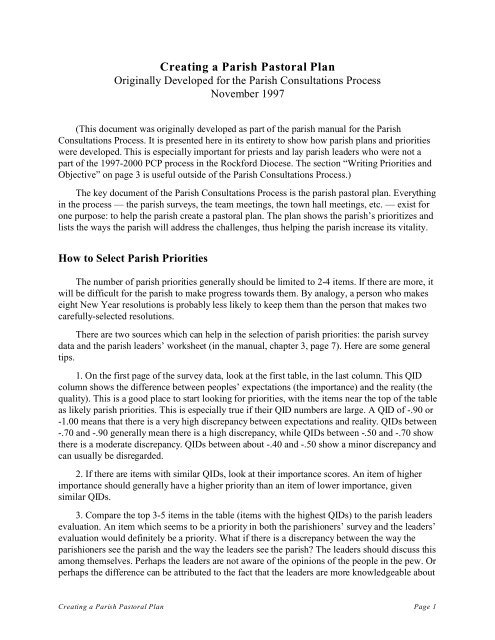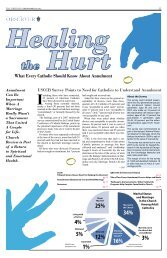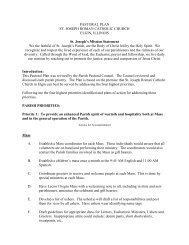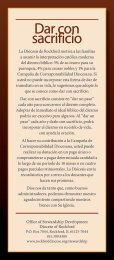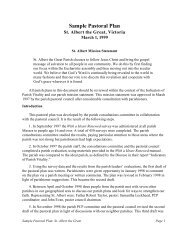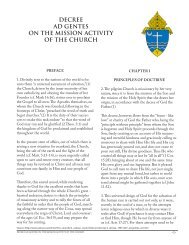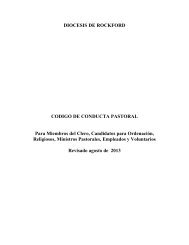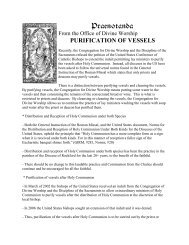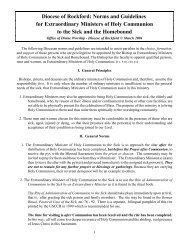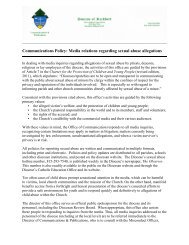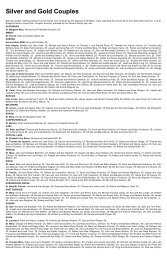Creating a Parish Pastoral Plan - Diocese of Rockford
Creating a Parish Pastoral Plan - Diocese of Rockford
Creating a Parish Pastoral Plan - Diocese of Rockford
Create successful ePaper yourself
Turn your PDF publications into a flip-book with our unique Google optimized e-Paper software.
<strong>Creating</strong> a <strong>Parish</strong> <strong>Pastoral</strong> <strong>Plan</strong><br />
Originally Developed for the <strong>Parish</strong> Consultations Process<br />
November 1997<br />
(This document was originally developed as part <strong>of</strong> the parish manual for the <strong>Parish</strong><br />
Consultations Process. It is presented here in its entirety to show how parish plans and priorities<br />
were developed. This is especially important for priests and lay parish leaders who were not a<br />
part <strong>of</strong> the 1997-2000 PCP process in the <strong>Rockford</strong> <strong>Diocese</strong>. The section “Writing Priorities and<br />
Objective” on page 3 is useful outside <strong>of</strong> the <strong>Parish</strong> Consultations Process.)<br />
The key document <strong>of</strong> the <strong>Parish</strong> Consultations Process is the parish pastoral plan. Everything<br />
in the process — the parish surveys, the team meetings, the town hall meetings, etc. — exist for<br />
one purpose: to help the parish create a pastoral plan. The plan shows the parish’s prioritizes and<br />
lists the ways the parish will address the challenges, thus helping the parish increase its vitality.<br />
How to Select <strong>Parish</strong> Priorities<br />
The number <strong>of</strong> parish priorities generally should be limited to 2-4 items. If there are more, it<br />
will be difficult for the parish to make progress towards them. By analogy, a person who makes<br />
eight New Year resolutions is probably less likely to keep them than the person that makes two<br />
carefully-selected resolutions.<br />
There are two sources which can help in the selection <strong>of</strong> parish priorities: the parish survey<br />
data and the parish leaders’ worksheet (in the manual, chapter 3, page 7). Here are some general<br />
tips.<br />
1. On the first page <strong>of</strong> the survey data, look at the first table, in the last column. This QID<br />
column shows the difference between peoples’ expectations (the importance) and the reality (the<br />
quality). This is a good place to start looking for priorities, with the items near the top <strong>of</strong> the table<br />
as likely parish priorities. This is especially true if their QID numbers are large. A QID <strong>of</strong> -.90 or<br />
-1.00 means that there is a very high discrepancy between expectations and reality. QIDs between<br />
-.70 and -.90 generally mean there is a high discrepancy, while QIDs between -.50 and -.70 show<br />
there is a moderate discrepancy. QIDs between about -.40 and -.50 show a minor discrepancy and<br />
can usually be disregarded.<br />
2. If there are items with similar QIDs, look at their importance scores. An item <strong>of</strong> higher<br />
importance should generally have a higher priority than an item <strong>of</strong> lower importance, given<br />
similar QIDs.<br />
3. Compare the top 3-5 items in the table (items with the highest QIDs) to the parish leaders<br />
evaluation. An item which seems to be a priority in both the parishioners’ survey and the leaders’<br />
evaluation would definitely be a priority. What if there is a discrepancy between the way the<br />
parishioners see the parish and the way the leaders see the parish The leaders should discuss this<br />
among themselves. Perhaps the leaders are not aware <strong>of</strong> the opinions <strong>of</strong> the people in the pew. Or<br />
perhaps the difference can be attributed to the fact that the leaders are more knowledgeable about<br />
<strong>Creating</strong> a <strong>Parish</strong> <strong>Pastoral</strong> <strong>Plan</strong> Page 1
the parish. In any case, the parish priorities should reflect both the broad opinions <strong>of</strong> the typical<br />
parishioner and the greater knowledge <strong>of</strong> the parish leadership.<br />
4. It is also important to note any new insights or suggestions that come from the<br />
parishioners after they see their data. Whether the parish presents the data at a town hall meeting<br />
or publishes it in the bulletin, parishioners should have some way to respond to the data. They<br />
may <strong>of</strong>fer ideas which improve the selection <strong>of</strong> parish priorities.<br />
How to Present the <strong>Pastoral</strong> <strong>Plan</strong><br />
The pastoral plan is composed <strong>of</strong> the several parts. Please compare the sample parish<br />
pastoral plan <strong>of</strong> St. Albert the Great to the following instructions. Note that some elements <strong>of</strong> the<br />
pastoral plan are required and others are optional.<br />
Mission Statement (optional). If the parish has a mission statement, this should be the first<br />
item. The mission statement is important because it shows the context in which the pastoral plan<br />
is to be understood. That is, the mission statement provides the “big picture” while the parish<br />
priorities are steps taken towards the mission.<br />
Please note: if the parish does not have a mission statement, it should not attempt to write<br />
one during the <strong>Parish</strong> Consultations Process. The development <strong>of</strong> a good mission statement<br />
requires significant time and consultations, which would conflict with the time demands <strong>of</strong> the<br />
PCP.<br />
Introduction (required). General comments on the procedures used to develop the pastoral<br />
plan should be next. The purpose is to give the reader enough basic information so that he or she<br />
has confidence in the priorities, i.e. that the priorities came out <strong>of</strong> the felt needs <strong>of</strong> the<br />
parishioners which were expressed in the Sunday Mass survey.<br />
The introduction could include basic information about:<br />
# the number <strong>of</strong> people surveyed at Mass in September ;<br />
# the leadership evaluation <strong>of</strong> the parish with the leaders’ worksheet;<br />
# the leadership review <strong>of</strong> the parish data;<br />
# presentation <strong>of</strong> the survey data to parishioners; and<br />
# review <strong>of</strong> comments from the parishioners about the survey data.<br />
Items <strong>of</strong> Highest Importance (optional). A parish may want to list here the five or ten items<br />
<strong>of</strong> highest importance to parishioners along with a short paragraph <strong>of</strong> explanation. If a parish<br />
wishes to present a list <strong>of</strong> all 34 survey items sorted by importance, it should append it to pastoral<br />
plan instead <strong>of</strong> taking up so much space at this point in the report.<br />
Items <strong>of</strong> Highest Quality (optional). A parish may also wish to list the items <strong>of</strong> highest<br />
quality. This list could be very affirming to parish leadership as it would call attention to those<br />
attributes which the parish does well. As with the items <strong>of</strong> highest importance, if a parish wishes<br />
to include the entire list it should append it to the report.<br />
<strong>Parish</strong> Priorities (required). At stated above, the number <strong>of</strong> priorities should generally be<br />
limited to 2-4 items. Each priority should have the following sections:<br />
Page 2\Chapter 5: Consultations
1. a well-conceived statement, expressing the priority in the form <strong>of</strong> a goal;<br />
2. an explanation <strong>of</strong> why this item should be a priority; and<br />
3. a series <strong>of</strong> objectives which will help the parish make progress in the priority.<br />
Please review the enclosed document on writing priorities and objectives. This will help in<br />
the creation <strong>of</strong> the pastoral plan. It will also ensure that when parishes meet in clusters to review<br />
each others’ pastoral plans, the plans will have a common form.<br />
Writing Priorities and Objectives<br />
Priorities. <strong>Parish</strong> priorities are analogous to goals. They are brief, clear statement <strong>of</strong> desired<br />
direction or activities, expressed in broad, general terms. The priorities should:<br />
# be guides to action — stated as a desired outcome, desired condition or result;<br />
# be general in their direction;<br />
# be both challenging and inspiring;<br />
# call for investment and involvement;<br />
# provide a long-range time line (3-5 years);<br />
# be tied to the mission <strong>of</strong> the universal or diocesan Church as well as the mission <strong>of</strong> the<br />
parish; and<br />
# be able to be attained through objectives and strategies.<br />
An example <strong>of</strong> a proper priority or goal is: to develop responsible lay leaders in all areas <strong>of</strong><br />
parish life, who by their example and invitation encourage all parishioners to share their talents.<br />
Objectives. The objectives are specific, time-oriented and realistic statements <strong>of</strong> what a<br />
parish is going to do, for whom, and when it will be done. The objectives are the concrete steps<br />
that a parish takes to move towards fulfilling the priorities. The objectives should:<br />
# begin with “to” and be followed by an action verb;<br />
# produce just one result;<br />
# specify for whom or with whom an action is done;<br />
# have a specific target date, preferably in the near future;<br />
# be quantifiable and measurable;<br />
# be clear and understandable;<br />
# be realistic and attainable in light <strong>of</strong> the parish’s human and fiscal resources; and<br />
# link with at least one priority.<br />
An example <strong>of</strong> a proper objective is: by May 31 to involve at least 15 people from the<br />
pastoral council and its commissions in two two-hour workshops on the theology <strong>of</strong> the parish<br />
and conflict resolution.<br />
Strategies or Tasks. It is not necessary to write strategies for the pastoral plan.<br />
Nevertheless, they are presented here for completeness. Strategies are the specific actions which<br />
need to be taken in the attainment <strong>of</strong> an objective. A group <strong>of</strong> strategies is an “action plan”<br />
<strong>Creating</strong> a <strong>Parish</strong> <strong>Pastoral</strong> <strong>Plan</strong> Page 3
specifying how an objective will be reached. After a pastoral plan is accepted, a parish may wish<br />
to formally write strategies for itself to make sure everything gets done. The strategies should:<br />
# name the individual(s) who are responsible for a specific action;<br />
# name the specific action for which they are responsible;<br />
# specify the date by which the action should be completed;<br />
# be linked to a specific objective; and<br />
# be tied in with other strategies.<br />
An example <strong>of</strong> a proper strategy is: by April 10 Robert Bernstein will meet with the finance<br />
council chair to determine a budget for the two workshops for pastoral council members and<br />
communicate the response to Mary Jones.<br />
Page 4\Chapter 5: Consultations
Sample <strong>Pastoral</strong> <strong>Plan</strong><br />
St. Albert the Great, Victoria<br />
February 8, 1998<br />
St. Albert Mission Statement<br />
St. Albert the Great <strong>Parish</strong> chooses to follow Jesus Christ and bring the gospel<br />
message <strong>of</strong> salvation to all people in our community. We do this by first finding<br />
our focus within the Eucharistic assembly and then moving out into the secular<br />
world. We believe that God’s Word is continually being revealed to the world in<br />
many fashions and that our role is to discern this revelation and cooperate with<br />
God’s grace wherever it is found.<br />
All parish plans in this document should be reviewed within the context <strong>of</strong> our parish<br />
mission statement. This mission statement was approved in March 1995 by the parish pastoral<br />
council after considerable consultation with parishioners.<br />
Introduction<br />
This draft pastoral plan was developed by the parish consultations committee in<br />
collaboration with the pastoral council. It is the result <strong>of</strong> the following steps.<br />
1. On September 13-14 the With a Heart Renewed survey was administered at all parish<br />
Masses to people age 16 and over. A total <strong>of</strong> 450 surveys were completed and processed by the<br />
<strong>Rockford</strong> <strong>Diocese</strong>. The parish consultations committee studied the results. Particular attention<br />
was paid to those areas where the parish was not strong but parishioners had high expectations.<br />
2. During October the parish staff, the consultations committee and the pastoral council<br />
completed a parish evaluation, using materials provided in the With a Heart Renewed manual .<br />
The parish was compared to the ideal parish, as defined by the <strong>Diocese</strong> in their report “Indicators<br />
<strong>of</strong> <strong>Parish</strong> Vitality.”<br />
3. In December a synopsis <strong>of</strong> the parish survey data was published in the bulletin and<br />
parishioners were invited to give their comments on the data. In addition, an open meeting was<br />
held in January where parishioners could look at the survey results in more detail and provide<br />
additional feedback to the parish consultations committee.<br />
4. The consultations committee met in January to write the first draft <strong>of</strong> the pastoral plan.<br />
The committee compared the survey results with its own evaluation <strong>of</strong> the parish, and also took<br />
into account the comments provided by parishioners after reviewing the parish survey data.<br />
<strong>Parish</strong> Priorities<br />
<strong>Creating</strong> a <strong>Parish</strong> <strong>Pastoral</strong> <strong>Plan</strong> Page 5
Priority 1: to provide a high-quality youth ministry program for our parish high school<br />
students, so that their faith might be strengthened and an experience <strong>of</strong> Christian community be<br />
developed among them.<br />
High school youth ministry is listed as the top priority here because the parish Mass surveys<br />
indicated that parishioners had a high desire for a strong youth ministry. This was confirmed by<br />
the parish leadership in their separate evaluation <strong>of</strong> the parish’s strengths and weaknesses.<br />
Furthermore, pastoral council members indicated that both parents and youth have been asking<br />
for a good youth ministry program for at least the last five years.<br />
The following objectives will help the parish address priority 1.<br />
Objective 1-1: by May 31, 1998 to have parish leaders meet with a representative <strong>of</strong> the<br />
Diocesan Youth Ministry Office to discuss our parish’s need to address youth ministry.<br />
Objective 1-2: during the summer <strong>of</strong> 1998, to identify 5-9 high school students, who seem<br />
to take an interest in parish life, and invite them to a meeting to discuss the needs <strong>of</strong> high school<br />
students.<br />
Objective 1-3: during the autumn <strong>of</strong> 1998 to host a youth evening, to which all parish high<br />
schools students will be invited.<br />
Objective 1-4: by 1999 to establish a “youth seat” on the pastoral council, with the youth<br />
representative being elected by high school parishioners.<br />
Priority 2: to increase the participation <strong>of</strong> young adults (ages 18-25) in active parish life,<br />
so that they may live out their baptismal commitment and the parish may receive their gifts and<br />
talents.<br />
Participation <strong>of</strong> young adults in the parish is the second priority because <strong>of</strong> its high ranking<br />
in both the parishioner Mass survey and the leadership evaluation. Many parishioners have<br />
expressed concern that once young people get married, they are not seen at church until the birth<br />
<strong>of</strong> their children.<br />
The following objectives will help the parish address priority 2.<br />
Objective 2-1: by the end <strong>of</strong> 1998 to have parish leaders research how other parishes in our<br />
size category engage young adults in their parish communities.<br />
Objective 2-2: by the end <strong>of</strong> 1999 to make a presentation to all parish groups, encouraging<br />
them to recruit young adults and presenting them with some ideas on how to do this.<br />
Objective 2-3: beginning in 2000 to provide young adults who are receiving preparation for<br />
either their marriage or the baptism <strong>of</strong> their children with a brochure which lists the opportunities<br />
for involvement in our parish.<br />
Page 6\Chapter 5: Consultations
Priority 3: to increase the experience <strong>of</strong> community within the parish, especially within the<br />
Sunday Eucharistic assembly, so that we might better live out our faith in support <strong>of</strong>, and<br />
supported by, one another.<br />
While there is general satisfaction with the Sunday Liturgies at our parish, sufficient<br />
concern was raised in the parishioner survey to make this item the third priority. Many people<br />
who have visited other parishes on vacation report a vibrant sense <strong>of</strong> community. They ask, “why<br />
can’t we have this at St. Albert.” The parish leadership evaluation concurs with them.<br />
The following objectives will help the parish address priority 3<br />
Objective 3-1: by June 30, 1998 to solicit assistance from the Diocesan Office <strong>of</strong> Divine<br />
Worship to help the parish improve Sunday Liturgies.<br />
Objective 3-2: during the autumn <strong>of</strong> 1998 to begin using greeters at all Sunday Masses to<br />
welcome people coming into church.<br />
Objective 3-3: during the autumn <strong>of</strong> 1998 to begin having c<strong>of</strong>fee and donuts available<br />
weekly in the church hall after the principal Sunday Mass and encourage people to meet other<br />
parishioners there.<br />
Objective 3-4: during the autumn <strong>of</strong> 1998 to begin the regular practice <strong>of</strong> publishing<br />
photographs <strong>of</strong> new parishioners in the parish bulletin.<br />
Objective 3-5: by the autumn <strong>of</strong> 1999 to invite new parishioners to a semi-annual potluck<br />
supper so they might meet other parishioners and find out more about opportunities for<br />
involvement in the parish.<br />
<strong>Creating</strong> a <strong>Parish</strong> <strong>Pastoral</strong> <strong>Plan</strong> Page 7


